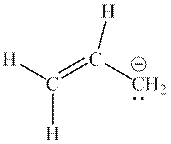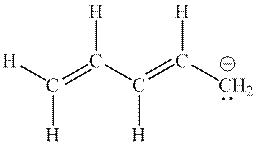
Concept explainers
(a)
Interpretation: The missing resonance structures for anion shown below should be determined.

Concept introduction:When one single structure is unable to describe all the properties of single molecule, a phenomenon called resonance comes into play. This arises when two or more than two Lewis structures are possible for one molecule. All such structures are called resonating structures and have same placement of atoms in them but these have different locations of bond pairs and lone pairs. The resonating structures are inter-convertible with each other. The resultant of all the resonating or contributing structures is called the resonance hybrid.
Rules to form resonance structure are as follows:
1. Use arrow types 1 and 2 for resonance structure of anions in movement of negative charge.
2. Use only arrow type 3 to move a positive charge for resonance structure of cations.
3. The sigma bond should not be broken. Any atom must not move from its place and total number of electrons must be same in all resonance structures.
(b)
Interpretation: The missing resonance structures for anion shown below should be determined.

Concept introduction: When one single structure is unable to describe all the properties of single molecule, a phenomenon called resonance comes into play. This arises when two or more than two Lewis structures are possible for one molecule. All such structures are called resonating structures and have same placement of atoms in them but these have different locations of bond pairs and lone pairs. The resonating structures are inter-convertible with each other. The resultant of all the resonating or contributing structures is called the resonance hybrid.
Rules to form resonance structure are as follows:
1. Use arrow types 1 and 2 for resonance structure of anions in movement of negative charge.
2. Use only arrow type 3 to move a positive charge for resonance structure of cations.
3. The sigma bond should not be broken. Any atom must not move from its place and total number of electrons must be same in all resonance structures.
(c)
Interpretation: The missing resonance structures for anion shown below should be determined.

Concept introduction: When one single structure is unable to describe all the properties of single molecule, a phenomenon called resonance comes into play. This arises when two or more than two Lewis structures are possible for one molecule. All such structures are called resonating structures and have same placement of atoms in them but these have different locations of bond pairs and lone pairs. The resonating structures are inter-convertible with each other. The resultant of all the resonating or contributing structures is called the resonance hybrid.
Rules to form resonance structure are as follows:
1. Use arrow types 1 and 2 for resonance structure of anions in movement of negative charge.
2. Use only arrow type 3 to move a positive charge for resonance structure of cations.
3. The sigma bond should not be broken. Any atom must not move from its place and total number of electrons must be same in all resonance structures.
Trending nowThis is a popular solution!

Chapter 5 Solutions
Custom eBook for Organic Chemistry
- Draw a reasonable resonance structure for the following species. Draw out all bonds to the oxygen atom in your answer.arrow_forwardDraw all reasonable resonance structures for the following compounds. Be sure to show the proper arrows to indicate electron movementarrow_forwardFor each of the following molecules, draw all the valid resonance formsarrow_forward
- For each of the following molecules, complete the following. (Please Explain) Draw the bond dipole for each polar bond. Indicate whether there is a net dipole or not using the blanks provided. You don’t need to provide the direction of the net dipole, only whether or not one exists.arrow_forwardDraw three additional resonance structures for the compound shown belowarrow_forwardDraw the other resonance structure for each molecule shown. For each, there is only one other structurearrow_forward
- Draw all possible resonance forms for anisole using appropriate arrow notation. Which resonance structure is most stable? Which is least stable? Draw the resonance hybrid for anisole, indicating all partial charges.arrow_forwardWhich of the highlighted chemical bonds in the molecules below is longest? Shortest? In between? Which highlighted bond requires the highest energy to break? Lowest? In between? Answer these questions by completing the second and third columns in the table.arrow_forwardWhich elements on the periodic table (other than H) are likely to form a+1 cation?arrow_forward
 Organic Chemistry: A Guided InquiryChemistryISBN:9780618974122Author:Andrei StraumanisPublisher:Cengage LearningChemistry: Matter and ChangeChemistryISBN:9780078746376Author:Dinah Zike, Laurel Dingrando, Nicholas Hainen, Cheryl WistromPublisher:Glencoe/McGraw-Hill School Pub Co
Organic Chemistry: A Guided InquiryChemistryISBN:9780618974122Author:Andrei StraumanisPublisher:Cengage LearningChemistry: Matter and ChangeChemistryISBN:9780078746376Author:Dinah Zike, Laurel Dingrando, Nicholas Hainen, Cheryl WistromPublisher:Glencoe/McGraw-Hill School Pub Co


